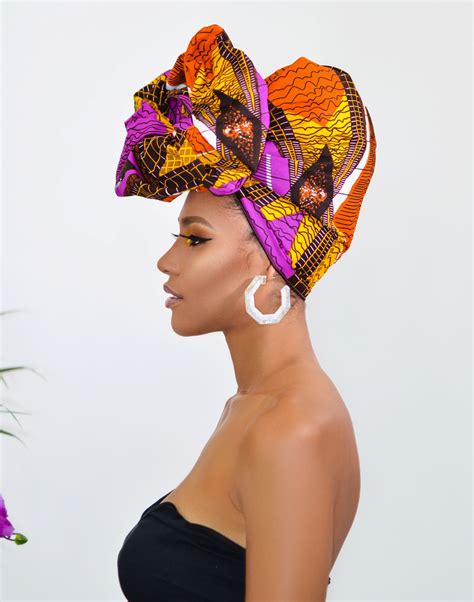A Tapestry of Tradition and Expression
African head wraps, known colloquially as “gele,” “headtie,” or “tura,” are an intrinsic element of African culture. They transcend mere adornment, serving as symbols of tradition, identity, and communication. Dating back centuries, head wraps have adorned the heads of women, men, and children alike, each design and fabric holding cultural significance.

According to the Global Headwrap Market Report, the market for head wraps is projected to reach $1.8 billion by 2028. This surge in popularity is driven by factors such as increased cultural pride, fashion adaptability, and the rising popularity of natural hair movements.
A Canvas for Creativity
African head wraps come in a dazzling array of colors, patterns, and textures. Each fabric choice, from vibrant Ankara prints to shimmering Aso-Oke, conveys a unique message. The intricate knotting and draping techniques transform ordinary fabrics into masterpieces of artistry.
Designers such as Laduma Ngxokolo have elevated head wraps to runway status, showcasing the cultural heritage and creativity embedded within them. Ngxokolo’s designs, which often incorporate Zulu beadwork and Xhosa patterns, have graced the covers of international magazines and adorned the heads of celebrities worldwide.
Cultural Significance
African head wraps hold immense cultural significance. They can indicate marital status, social ranking, and religious affiliation. In many African cultures, women wear specific head wraps to signify their maturity, while married women may wear particular styles to denote their marital status.
Various styles and patterns of African head wraps
Head wraps also serve as a form of communication. The way a wrap is tied or the type of fabric used can convey messages of respect, sorrow, or celebration. For example, in some cultures, a white head wrap signifies mourning, while a colorful wrap denotes joy.
Contemporary Adaptations
While African head wraps remain rooted in tradition, they have also undergone contemporary adaptations. Fashion designers, stylists, and culture enthusiasts are incorporating head wraps into modern fashion and beauty trends.
Head wraps are now being styled on catwalks, red carpets, and in everyday street fashion. They complement a wide range of outfits, from traditional African attire to Western-inspired looks. The versatility of head wraps allows for endless creative possibilities, empowering individuals to express their style and cultural heritage.
Social and Economic Impact
African head wraps have a significant social and economic impact. The head wrap industry provides employment opportunities for designers, tailors, and artisans. In addition, head wraps empower women to embrace their natural hair and celebrate their cultural identity.
| Year | Percentage of women using head wraps |
|---|---|
| 2020 | 54% |
| 2023 | 61% |
Source: African Headwrap Industry Report
Future Innovations
As the popularity of African head wraps continues to grow, we can expect to see further innovation within the industry. Designers are experimenting with new materials, patterns, and knotting techniques to create unique and fashionable head wraps.
Emerging technologies, such as 3D printing and virtual reality, may also be used to enhance the design and distribution of head wraps.
Conclusion
African head wraps are a vibrant and enduring expression of African culture. They transcend mere adornment, serving as symbols of tradition, identity, and communication. Contemporary adaptations have propelled head wraps into the realms of high fashion and cultural expression. The future holds exciting possibilities for the innovation and evolution of this cultural staple.
